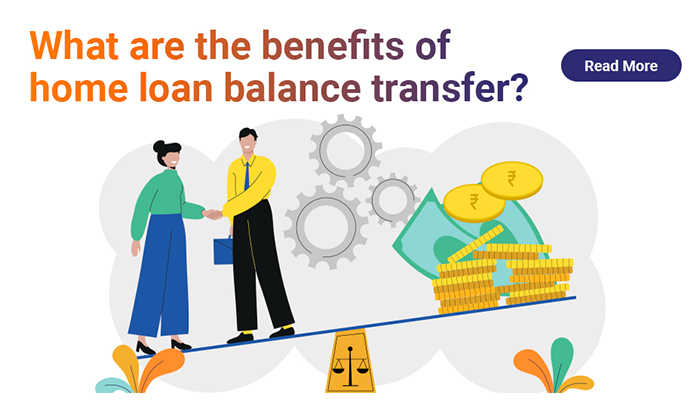How to Transfer Home Loan from One Bank to Another?

If you’re stuck with a high-interest home loan, switching lenders through a home loan balance transfer might be your smartest financial move. It is an effective way to reduce your interest rate burden and enjoy better debt conditions to transfer a home loan from one bank to another.
Whether you are targeting a low EMI, better service, or additional features, a home loan transfer can help adapt the repayment journey. Let's understand how the process works and the factors you should consider before you proceed.
What is a Home Loan Balance Transfer?
A home loan balance transfer involves moving your existing loan from one lender (bank or NBFC) to another, typically for a lower home loan interest rate or better service. The new lender pays off your outstanding loan amount to your current lender, and you start repaying the new lender under revised terms.
This is especially beneficial if:
- Interest rates have dropped since you took out your loan
- Your financial profile has improved
- You want to consolidate loans or avail a top-up loan
- Your current lender’s service is unsatisfactory
Key Benefits of a Home Loan Transfer
Some advantages of a home loan transfer are:
-
Lower Interest Rates
The most common reason borrowers consider a transfer is to take advantage of reduced interest rates. Even a small reduction can result in significant savings.
-
Top-Up Loan Facility
Most NBFCs and banks offer the option to avail of a top-up loan on the transferred home loan. It can be used for renovation, education, medical expenses, or other needs.
-
Improved Loan Terms
You can renegotiate terms such as tenure, repayment mode, and even request flexible EMI options based on your current financial position.
-
Better Service and Digital Management
Switching to a lender like IIFL Home Loans provides access to superior customer service, quick processing, and convenient online management tools.
-
Lower EMI Burden
With lower interest rates, your monthly instalments are reduced, improving your monthly cash flow.
Documents Required for Home Loan Transfer
Here's a quick checklist of all the documents you'll need:
Personal KYC:
- Aadhaar Card
- PAN Card
- Passport (for NRI applicants)
Income Documents:
- Salaried: Salary slips, Form 16, bank statements
- Self-employed: ITRs, business proof, CA-certified financials
Property Documents:
- Sale deed
- Possession letter
- Approved building plan
- Occupancy certificate
Loan Documents:
- Foreclosure letter
- Loan repayment track record
- Sanction letter from the existing lender
Step-by-Step Process of Home Loan Transfer
Here’s how to transfer a home loan from one bank to another:
Step 1: Evaluate Your Current Loan Situation
Before initiating the transfer, analyse your:
- Current outstanding principal
- Existing interest rate
- Remaining loan tenure
- Processing fees from the new lender
- Prepayment penalties or foreclosure charges
Step 2: Compare Lenders and Offers
Next, research lenders who offer attractive interest rates and services. Look at interest rates, processing and legal fees, top-up loan options and customer service track record.
Step 3: Apply with the New Lender
Once you’ve selected a lender, submit a loan transfer application.
Step 4: Loan Approval and Verification
The new lender will verify your creditworthiness, evaluate your income and property documents, and assess your repayment history. If satisfied, the lender will sanction your loan transfer.
Step 5: Foreclosure of Existing Loan
Once your new loan is sanctioned, the new lender will issue a cheque or a demand draft in favour of your existing lender for the outstanding amount.
Step 6: Loan Disbursal and EMI Start
After the closure of the old account, the new lender disburses the loan and provides you with a new repayment schedule. Your EMI under the new terms starts from the next cycle.
Factors to Consider Before a Home Loan Transfer
Before transferring your home loan to another lender, keep the following crucial factors in mind:
-
Timing of transfer
Balance transfer makes more sense in the early years of the loan tenure when interest outgo is higher. Transferring in later years may not yield significant savings.
-
Credit score
Always maintain a good credit score (ideally above 700) for a hassle-free transfer process. A poor score might lead to higher interest or rejection.
-
Top-up loan options
If you foresee a financial requirement shortly, choose a lender that offers home loan top-up facilities alongside the transfer.
-
Cost of transfer
Home loan transfer from one bank to other charges are typically incurred under multiple heads, such as for processing fees, legal charges, valuation fees, and administration.
-
Tenure adjustment
Choose whether you want to reduce the EMI or the tenure. Shortening the loan tenure is advisable to save more on interest.
Wrapping Up
It’s wise to transfer a home loan to another bank with the right lender and at the right time to maximise benefits like lower interest rates and better loan terms. It helps you reduce the overall cost of borrowing, manage EMIs better, and even access additional funds through top-up loans.
However, it is essential to consider all associated costs and compare offers carefully before making the switch. With NBFCs like IIFL Home Loans offering tailored solutions, low documentation requirements, and flexible repayment options, the loan balance transfer process has become more streamlined. This makes it more accessible and faster than ever.
FAQs
Q1. What are the benefits of transferring home loans?
Key benefits include reduced interest rates, lower EMIs, better customer service, and top-up loan options.
Q2. Is there a minimum outstanding loan amount needed to transfer?
Most lenders require a minimum balance outstanding, generally around ₹5 to 10 lakh, although this varies by institution.
Q3. Are there any charges involved in a home loan transfer?
Yes, depending on the lender, charges may include processing fees, legal fees, valuation charges, and administrative fees.
Q4. When is the right time to transfer a home loan?
The best time is usually during the early or mid-tenure of your loan when interest savings are the highest.
Q5. What documents are required for a home loan transfer?
You’ll need your loan statement, foreclosure letter, KYC documents, income proof, property documents, and a No Objection Certificate (NOC) from your existing lender.
Tags
Disclaimer: The information contained in this post is for general information purposes only. IIFL Home Finance Limited (including its associates and affiliates) ("the Company") assumes no liability or responsibility for any errors or omissions in the contents of this post and under no circumstances shall the Company be liable for any damage, loss, injury or disappointment, etc. suffered by any reader. All information in this post is provided "as is", with no guarantee of completeness, accuracy, timeliness, or of the results, etc. obtained from the use of this information, and without warranty of any kind, express or implied, including, but not limited to warranties of performance, merchantability, and fitness for a particular purpose. Given the changing nature of laws, rules, and regulations, there may be delays, omissions, or inaccuracies in the information contained in this post. The information on this post is provided with the understanding that the Company is not herein engaged in rendering legal, accounting, tax, or other professional advice and services. As such, it should not be used as a substitute for consultation with professional accounting, tax, legal or other competent advisers. This post may contain views and opinions which are those of the authors and do not necessarily reflect the official policy or position of any other agency or organization. This post may also contain links to external websites that are not provided or maintained by or in any way affiliated with the Company and the Company does not guarantee the accuracy, relevance, timeliness, or completeness of any information on these external websites. Any/ all (Home/ Loan Against Property/ Secured Business Loan/ Balance Transfer/ Home Improvement Loan/ NRI Home Loan/ Home Loan for Uniformed Services) loan product specifications and information that may be stated in this post are subject to change from time to time, readers are advised to reach out to the Company for current specifications of the said (Home/ Loan Against Property/ Secured Business Loan/ Balance Transfer/ Home Improvement Loan/ NRI Home Loan/ Home Loan for Uniformed Services) loan.
 Login
Login





















